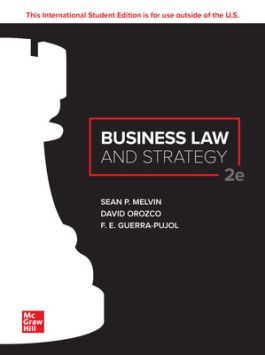Business Law and Strategy ISE
After purchasing your eBook, login to the McGraw Hill Bookshelf website and redeem the access code from your order confirmation email.
- Access your eBook online or offline
- Easily highlight and take notes
- Fully searchable content
- Syncs across platforms
NOTE: eBook purchase does not include Connect homework or adaptive SmartBook assignments
UNIT ONE: FUNDAMENTALS OF THE LEGAL ENVIRONMENT OF BUSINESS
Chapter 1: Legal Foundations and Thinking Strategically
Chapter 2: Business, Societal, and Ethical Contexts of Law
Chapter 3: Business and the Constitution
Chapter 4: The American Judicial System, Jurisdiction, and Venue
Chapter 5: Resolving Disputes: Litigation and Alternative Dispute Resolution
Chapter 6: International Law and Global Commerce
Chapter 7: Privacy Law and Information Management
UNIT TWO: CONTRACTS, SALES, AND LEASES
Chapter 8: Contracts: Overview, Mutual Assent, and Consideration
Chapter 9: Capacity and Legality
Chapter 10: Enforceability
Chapter 11: Performance
Chapter 12: Breach and Remedies
Chapter 13: Sales: Overview of Article 2
Chapter 14: Sales Contracts: Agreement, Consideration, and the Statute of Frauds
Chapter 15: Title, Allocation of Risk, and Insurable Interest
Chapter 16: Performance and Cure in Sales Contracts
Chapter 17: Breach and Remedies in a Sales Transaction
Chapter 18: UCC Article 2A: Lease Contracts
Chapter 19: Sales Warranties
UNIT THREE: COMMERICIAL PAPER AND SECURED TRANSACTIONS
Chapter 20: Negotiable Instruments: Definition, Creation, and Categories
Chapter 21: Negotiation, Indorsements, and Holder in Due Course
Chapter 22: Liability, Defenses, and Discharge
Chapter 23: Checks, Deposits, and Financial Institutions
Chapter 24: Secured Transactions
Chapter 25: Creditors’ Rights
Chapter 26: Bankruptcy and Alternatives
UNIT FOUR: BUSINESS ENTITIES
Chapter 27: Choice of Business Entity and Sole Proprietorships
Chapter 28: Partnerships
Chapter 29: Limited Liability Companies
Chapter 30: Corporations: Formation and Organization
Chapter 31: Corporate Transactions: Acquistions and Mergers
UNIT FIVE: REGULATIONS OF SECURITIES, CORPORATE GOVERNANCE, AND FINANCIAL MARKETS
Chapter 32: Overview of the Securities Market: Definition, Categories, and Regulation
Chapter 33: Regulation of Issuance: The Securities Act of 1933
Chapter 34: Regulation of Trading: The Securities Exchange Act of 1934
Chapter 35: Regulation of Corporate Governance and Financial Markets
UNIT SIX: AGENCY AND EMPLOYMENT LAW
Chapter 36: Agency Formation, Categories, and Authority
Chapter 37: Duties and Liabilities of Principals and Agents
Chapter 38: Employment at Will
Chapter 39: Employment Regulation and Labor Law
Chapter 40: Employment Discrimination
UNIT SEVEN: REGULATORY ENVIRONMENT OF BUSINESS
Chapter 41: Torts and Products Liability
Chapter 42: Administrative Law
Chapter 43: Consumer Protection
Chapter 44: Criminal Law and Procedure
Chapter 45: Insurance Law
Chapter 46: Environmental Law
Chapter 47: Antitrust and Regulation of Competition
UNIT EIGHT: PROPERTY
Chapter 48: Personal Property, Real Property, and Land Use Law
Chapter 49: Wills, Trusts, and Estates
Chapter 50: Intellectual Property

